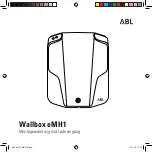
IV . CHARGER PRECAUTIONS
:
1. NEVER
charge a frozen battery.
2. Make sure the cord is located so that it will not be stepped on, tripped over, or otherwise subjected to
damage or stress.
3.
Do not operate the charger with a damaged cord or plug; replace them immediately.
4. Do not operate the charger if it has received a sharp blow, been dropped, or otherwise damaged.
5.
Do not disassemble the charger. Incorrect reassembly may result in a risk of electric shock and fire.
6. To reduce the risk of electric shock, disconnect the charger from the AC source before attempting any
maintenance or cleaning.
7. LOCATION OF CHARGER
: The charger should be mounted on ground vehicle floor, ventilated compart
-
ment or other suitable surface as close to the batteries to be charged as possible. Do not block the char-
ger’s fan or air intakes. Do not mount the charger directly over the batteries as fumes may cause exces-
sive corrosion. The area should be well ventilated and free from excessive moisture, exhaust manifolds,
and battery fumes. For maximum performance, the charger should not be located in an area of extreme
high temperature. The charger is not waterproof. Do not mount the charger where there is a possibility of
water entering the unit. Evidence of water entry into the charger will void the warranty.
8. CAUTION
: Do not attempt to increase battery bank capacity by splitting the output of one of the banks
with a diode-type battery isolator. The diode isolator lowers the charger voltage and results in under-
charging the batteries connected to it. If additional capacity is required it is preferable to add another
isolated or parallel battery.
V. GROUND AND AC POWER CORD CONNECTION
:
1. The charger should be grounded via the AC power connection to reduce the risk of electrical shock.
2. The charger must be plugged into or wired to an outlet that is an over-current protected 3 prong outlet.
Alternatively, it may be routed through a separate dedicated fuse or circuit breaker on an AC distribution
panel with proper earth/safety ground. All wiring shall comply with UL recommendations, NEC or NFPA
standards and local ordinances. Never alter the AC cord or plug if provided. Any modification of the
cord must only be done by a qualified electrician. Improper cord/outlet connection may result in a risk of
electrical shock.
3. Observe color coding of the AC wiring as follows:
Black………....................... AC Hot or LINE (fused)
White…………................... AC Neutral
Green…….................…….. AC Ground (safety/earth) ,
4. A branch rated overcurrent protection shall be provided for the AC terminal output blocks.
5. CAUTION
: (230 VAC applications only): If AC input is provide from a source consisting of two HOT or
LINE leads (phase-to-phase 230 VAC input voltage); an external fuse or circuit breaker must be used to
protect both hot leads.
6. CAUTION
: To reduce the risk of fire, connect only to an AC circuit provided with a 50A maximum branch
circuit overcurrent protection in accordance with the National Electrical Code, ANSI/NFPA 70.
III . PRECAUTIONS WHEN WORKING WITH BATTERIES
:
1. If battery acid contacts skin or clothing, wash immediately with soap and water. If acid enters eye, imme-
diately flood eye with running cold water for at least 20 minutes and get medical attention immediately.
2.
Never smoke or allow a spark or flame in vicinity of battery or engine.
3. Do not drop a metal tool on the battery. The resulting spark or short-circuit on the battery of other elec-
trical part may cause an explosion.
4. Remove personal metal items such as rings, bracelets, necklaces, and watches when working with a
lead-acid battery. A lead-acid battery produces a short-circuit current high enough to weld a ring or the
like to metal, causing a severe burn
5. To reduce the risk of injury, charge only rechargeable batteries such as deep-cycle lead acid, lead an-
timony, lead calcium gel cell, absorbed mat or NiCad/NiFe. Other types of batteries may burst, causing
personal injury and damage.
6. Don’t install the inverter near batteries, the inverter may heat battery electrolyte and cause corrosive
fumes to vent and damage/corrode nearby electronics or metals.
IMPORTANT SAFETY INSTRUCTIONS
4
170 Cherry Avenue
West Sayville, NY 11796
www.kussmaul.com
Ph: 800-346-0857
Fax: 631-567-5826





































